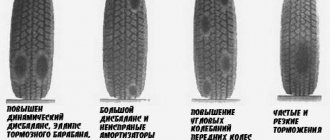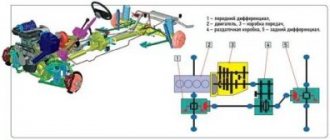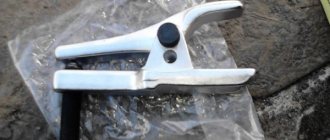What is antiresonance
When oscillations occur in the automobile unit on which the dynamic vibration damper is installed, it begins to oscillate in the opposite direction (antiphase), due to which the beat amplitude decreases. And this happens due to the phenomenon of anti-resonance.
Technically, this is realized using an elastic connection of a unit of a certain rigidity with a vibration damper, as well as the inertia of the latter, which any object has. Inertia depends on the massiveness of the object. Inertia is the ability of an object to resist forces exerted on it due to its weight.
Niva vibration damper, where and how to fix it with your own hands
You can install as many as three vibration dampers on a Niva; as a rule, these are places near the engine, cardan shafts and near the transfer case. Installation of this device does not require any skills and is carried out independently.
Installation recommendations:
- Unscrew the fastening bolt of the gearbox support.
- Next, you need to cut off the welded nut from the gearbox cross member.
- We install the bolt with the right mounting plate of the vibration damper in the direction of travel of the vehicle into the gearbox support.
- We install the left mounting plate of the vibration damper in the direction of travel of the vehicle onto the bolt.
- Tighten the vibration damper mounting plates using a nut, after installing the washer.
- Now you need to hang the vibration damper on the mounting plates, install the washers and secure them with a nut on both sides.
Also interesting: What you need to know about the VAZ 21214 engine before buying a Niva | Weak engine
Test No. 3
If no vibration is detected in Tests No. 1 and No. 2, proceed to Test No. 3. Accelerate the vehicle to a vibration-producing speed and place the transfer case and transmission levers in neutral. If the vibration persists, then its cause is a malfunction of the front or rear driveshafts (imbalance, jamming of the cardan joints) or an imbalance of the center differential.
Because You are not logged in. To come in.
Because The topic is archived.
After this, the cardans seem to need to be balanced. ¶
After this, the cardans seem to need to be balanced.
Dynamic vibration damper @ Niva 4×4
Yesterday I installed a vibration damper, today I went to work and was horrified - I never had such noise and vibrations even with a crooked wheel and a misaligned transfer case.
up to 2.5 thousand revolutions - everything is approximately as it was, only vibrations appeared, they did not seem strong, but they were felt even with your foot on the gas pedal.
from 2.5 to 3.1 thousand revolutions (actually the most “running”) there is a feeling that the car I have is my own age and there is simply no noise and vibration insulation.
after 3.1 thousand revolutions it seems normal, but I wouldn’t say that it was worse before.
I think the vibration damper is to blame for all this, or the fact that the car is somewhat skewed may have something to do with it - after replacing the springs (yesterday), the muzzle lifted up and the rear sank
§
Hello, dear Forum members!
It’s nice to read such flattering reviews, but I want to clarify the situation a little
The “vibration damper” was configured with the calculation of the maximum reduction in vibrations in intensive acceleration modes and at steady speeds of 90...110 km/h. For owners of cars of previous versions, the difference will be felt, as they say, “immediately”, for others it will be taken for granted (“and I would like it better”). We are working here and perhaps soon we will delight you with another innovation. As for costs, the installation of a DVG (Dynamic Vibration Damper) does not affect costs (the physical process of reducing vibrations does not affect the load characteristics of the engine and internal losses in the mechanics of the car). If we compare the costs of a car in 2020 and the current one, then a reduction must be required, but it is associated with the use of an electronic gas pedal. E-gas will provide a better mixture formation process, which directly leads to a reduction in costs in basic operating modes.
§
Yaro:
Why didn’t they introduce DVG on ShNiva? And in fact, on my ShNiva, all transmission vibrations went away after installing cardans with CV joints, and fuel consumption also decreased significantly. DVG reduces vibrations from the power unit, as I understand it? If so, is it possible to install it on the ShN?
For the Chevrolet Niva, the DVG was developed in 2005 (but did not go into production). Because Since cars 21214 and 2123 have different power unit suspensions, the vibration damper from 21214 will not fit on 2123 (there will be no effect).
Also interesting: Engine tuning: Niva 4x4 - increasing power using common methods "
The introduction of a CV joint also reduces the level of vibration, but the physical process of reduction is completely different (more effective). In addition, the CV joint reduces fur. losses in the transmission, which leads to reduced fuel consumption. The maximum effect in reducing noise and vibration can be achieved by combining CV joints and CV joints. (Let's keep our fingers crossed that it happens on 21214 :))
Added after 16 minutes 59 seconds:
Oleg 4x4:
Damn, how do you do this, I have 12.2 - 12.5, well, it doesn’t go any lower...
As for expenses.
For engines with E-Gas, the normal OPERATING consumption for the combined cycle can be considered to be 9.5...10.2 l/100 km.
Because Since the Niva has a fairly “loaded” engine, the amount of expenses depends very much on the driving modes. The first significant value is “one-time mileage” - the more the car drives “after the first start,” the lower the average consumption. The second significant value is driving style. If you like “active” driving with frequent gear changes, a lot of braking and acceleration within one gear, then be prepared to increase costs by an average of 1-1.5 liters. The more the car moves at a relatively constant speed, the lower the consumption.
But the consumption of 12.5 liters when driving on asphalt roads is still too high. Of course, there can be many reasons, from fuel quality to workmanship, but it makes sense to look at the first reason in rolling resistance (tightened handbrake, incorrect bearing adjustment, jammed front pads)
Added after 10 minutes 42 seconds:
yonnex001:
It’s possible, but they aren’t even on sale at PSSS yet. Only in warranty stock. The price is supposed to be around 1-1.5 thousand rubles. It's not difficult to install yourself. You can install from the first 2121 to the last 21214-2131.
Absolutely correct remark, and unfortunately I cannot please you, the “secondary” market “does not obey” AVTOVAZ. It’s difficult to say when such hardware will appear on the market :(. But if there is demand, then there will be supply. One important point is that as for the “hardware”, they can be, in principle, “any”, but the DVG itself is not a complicated thing, though from a production point of view, but from the point of view of engineering and technology, it is very difficult. If the characteristics are incorrectly selected, the DVG will either give nothing or will even worsen the situation.
Niva Chevrolet transfer case alignment
> Miscellaneous
Articles Loading...
Determining the causes of vibration and centering the transfer case
We remember the vehicle speed and engine speed at which vibration occurs in the transfer case mounting area.
With the car stationary, move the gearbox and transfer case levers to neutral and start the engine. We set the crankshaft speed corresponding to the vehicle speed at which vibrations occurred. If vibration persists, check the condition and fastening of the power unit supports.
If no vibrations are detected, repeat the previous test by engaging direct transmission in the gearbox. If vibration appears this time, the intermediate shaft is faulty (the flanges are loose, the hinge is stuck, the elastic coupling is cracked, etc.).
If there are no vibrations, accelerate the car slightly above the marked speed and move the gearbox and transfer case levers to the neutral position. The causes of vibration in this case are an imbalance of the center differential, front or rear driveshafts, or jamming of their hinges.
We also check the fastening of the transfer case to the body: the condition of the rubber-metal supports (tears and peeling of rubber are unacceptable), the tightening of the nuts, the absence of fatigue cracks on the body.
Before centering the transfer case, we check the condition of the power unit supports and the correct installation (the centering washers of the engine mounts must fit into the corresponding holes in the side brackets). We install the transfer case on the car without fully tightening the nuts securing the brackets for its suspension.
By moving the transfer case in the longitudinal, transverse and vertical directions (tightening or loosening the nuts of its fastening), we achieve a minimum and uniform gap between the flanges of the intermediate shaft and the drive shaft of the transfer case (the flanges must be at the same level and parallel to each other).
We fill the gap between the body floor and the supports with adjusting shims and align the centering belts of the flanges, slightly moving the transfer case forward (by the amount of the gap between the flanges). Finally tighten the nuts securing the transfer case supports.
Balancing the transfer case on the Niva. By popular demand.
Aligning the NIVA Transfer Case Without a lift 3 Ways to Center the NIVA Transfer Case
How to adjust the transfer case on a Niva and help from ZELLO
Transfer case alignment Niva Chevrolet 2123
how to adjust the transfer case on a field video
Centering of the Niva transfer case.
Chevrolet Niva Vibration. Checking the leak. 3rd support. Vibration of Chevrolet Niva transfer case. Causes
Using a transfer case on a Chevrolet Niva.
Balancing the transfer case in the field
August 30, 2016
This operation can help remove vibration, or at least it will be interesting and educational, like this miracle car. As practice has shown, this does not save you from replacing cardans with worn splines and broken crosspieces on an old car, but on a new one with good cardans and bearings on the shafts it helps. AS A CONSEQUENCE, THE TRANSFER LEVER NO LONGER CONVULSES, even on a Niva with high mileage. Take steel wire
1 mm, plasticine or hot glue as desired. We put the box and transfer case in neutral. We are looking for a helicopter bolt on the shaft donut from the gearbox side (important!) that corresponds well with the CV joint nut on the transfer case side. (On a helicopter there are 3 bolts on the CV joint and 4 nuts, but one pair is the same). Remove the speed sensor.
We fasten the wire and bend it so that when rotating it does not touch the gearbox lever housing. We bring the ends of the wires together at the point where we decided to start (leave a 1-2 mm gap) and rotate the structure. Our task is to rotate the ends of the wire nose to nose EVERYWHERE.
For this, all means are good: we bore the transfer case fasteners (for rotation), put washers under the supports, where there is no need to remove the washers. A big THANK YOU for the idea and advice to the honorary grower of the city of Goryachy Klyuch Vladimir Shubin!
Chevrolet Niva L › Logbook › Balancing cardans and transfer case on Chevrolet Niva
Causes of vibration and how to deal with it Reading our forum, you often come across a cry from the heart: “Help - vibration.” In this regard, I decided to share my thoughts on the fight against vibration and talk about how I finally defeated it.
Causes of vibration
1. Imbalance of cardans. The reason is still not the most common. An imbalance in a normal cardan appears only if it is bent or if it is repaired, or the crosspiece or flange is replaced. In addition, an imbalance appears after, due to wear of the spline or crosspiece bearing, as well as wear of the transfer case or axle bearing, the cardan is displaced from the axis of rotation under which it was balanced.
2. Tight rotation of the crosses.
Usually drivers do not think about this, but in the case of tight rotation of the crosspiece, the force expended on this rotation is transmitted to the suspension elements of the units, and from them to the body. I won’t draw vectors, but the tighter the crosspiece, the more the transfer case deviates on its pads. And since with each revolution the crosspiece turns first in one direction, then in the other, then, accordingly, the vibration frequency is 2 times higher than the frequency of rotation of the cardan. A symptom of this particular problem is a hum, very similar to the hum of a bridge.
For example, I thought that my RZM.3 would soon “bend.” Large angles of crossing of the cardan flanges. The literature says: the drive must be “homokinetic”, this means that both flanges must be parallel to each other. In fact, this is ideal. In any case, deviations should be minimal. With proper alignment, the Niva turns out to be about 5-7 degrees (measured with a school protractor with a weight, so the accuracy is plus or minus a bast shoe).
Dynamic vibration damper for fields, advantages and disadvantages
On Niva, when driving at a speed of 90 kilometers per hour or more, an increase in vibrations of the vehicle interior elements is observed. A high-quality vibration damper can reduce and eliminate vibrations from units. This part lasts for about 8-10 years. The device for Niva costs about 2800 rubles.
And also interesting: LADA 4×4 3 doors. – Operating manual – Official LADA website
The disadvantage of a dynamic vibration damper is its limited ability to operate at certain vibration frequencies. In the process of creating such devices, developers are faced with the task of determining the resonant frequency.
How to get rid of vibration in the field
Reading our forum, you often come across a cry from the heart: “Help - vibration.” In this regard, I decided to share my thoughts on the fight against vibration and talk about how I finally defeated it.
1. Imbalance of cardans. The reason is still not the most common. An imbalance in a normal cardan appears only if it is bent or if it is repaired, or the crosspiece or flange is replaced. In addition, an imbalance appears after, due to wear of the spline or crosspiece bearing, as well as wear of the transfer case or axle bearing, the cardan is displaced from the axis of rotation under which it was balanced.
2. Tight rotation of the crosses.
Usually drivers do not think about this, but in the case of tight rotation of the crosspiece, the force expended on this rotation is transmitted to the suspension elements of the units, and from them to the body. I won’t draw vectors, but the tighter the crosspiece, the more the transfer case deviates on its pads. And since with each revolution the crosspiece turns first in one direction, then in the other, then, accordingly, the vibration frequency is 2 times higher than the frequency of rotation of the cardan. A symptom of this particular problem is a hum, very similar to the hum of a bridge. For example, I thought that my REM would soon “bend.”
3. Large angles of crossing of the cardan flanges.
The literature says: the drive must be “homokinetic”, which means that both flanges must be parallel to each other. In fact, this is ideal. In any case, deviations should be minimal. With proper alignment, the Niva turns out to be about 5-7 degrees (measured with a school protractor with a weight, so the accuracy is plus or minus a bast shoe). In this case, the angle of rotation of the cross should also not exceed 8 degrees (this is from memory, I could be wrong, correct me if I do).
The kinematics of the Niva can be represented by the following diagram (as it turned out):
It can be seen that we do not have a single homokinetic driveshaft. The RPM is tilted forward approximately 6 degrees (angle E). REM back by about the same amount (angle F). Engine and gearbox back approximately 5 degrees (angle A). In this case, the remaining angles are within the tolerance only if the steering wheel is installed parallel to the bottom of the body.
Look at the picture. The front cardan is almost coaxial with the RPM shank, and the angle D is less than the coveted 8 degrees. Of course, not everything is in order with the rear cardan, I did not measure angles B and C. But I can say for sure that their difference is equal to angle F. And it, as I already said, is about 6 degrees. Without thinking, I somehow tried to push the REM back even more. The vibration only intensified. Therefore, I concluded that the smaller F, the less vibration. As for the CV joint, it is important that the axis of the secondary shaft of the gearbox and the axis of the primary shaft pass strictly through its center. We achieve this by centering the transfer case.
1. Cardan shafts must be balanced. 2. The crosspieces should rotate easily in their bearings, and the force should be the same. 3. The transfer case must be centered so that the axes of its secondary shafts are parallel to the bottom of the body and parallel to the longitudinal axis of the vehicle. At the same time, it must be set so that the axis of the secondary shaft of the gearbox passes strictly through the center of the CV joint of the shaft. 4. There should be no play in the crosspieces, splined joints and bearings of the secondary shafts of the RK
Practical recommendations (experience is the son of difficult mistakes)
Selection of cardans and shafts
When you go to the store to buy cardans, do not give in to provocations. Cheaper is not always better. The signs of a proper wash are: - not painted, but blued metal; — presence of balancing drillings on the CV joint; Moreover, inside these drillings the metal is bare, not painted over or blued; — the presence of balancing washers on the bolts that secure the elastic coupling; — balancing washers and holes on the CV joint are located approximately on one side (as if they compensate each other); I don’t know why, but when dynamically balancing a normally balanced cardan it turns out this way; — The CV joint should turn tightly (not worn in), but evenly; - quality of rubber bands.
Dynamic vibration damper, operating principle
When vibration occurs up and down, the vibration damper inertly counteracts this due to a non-rigid, elastic connection. Otherwise, it would begin to oscillate with the car assembly together as one. Through this elastic mount, the vibration damper transfers energy of the opposite direction to the unit.
However, this same connection, due to its elasticity, as a result moves the vibration damper down. By this moment the unit is already beginning to move upward. In this case, the vibration damper is no longer at rest, but moves in the opposite direction. Because of this, its inertia becomes even greater, and, consequently, significant opposition.
Operating principle and application of vibration damper
In any case, vibration damping is carried out by absorbing vibration energy or increasing losses when overcoming the inertial or elastic resistance of the vibration damper.
Dynamic vibration damper for Niva
The scope of use of vibration dampers is quite wide and the number of design solutions for their implementation is just as large. They are capable of suppressing vibration of gearboxes and electric motors, on pipelines and drilling machines, in refrigeration units and other mechanisms and devices. They are: dampers, spring-loaded pistons, chokes, shock absorbers, expanding pipeline links, flexible and rigid reflectors in the form of partitions, various counterbalance-oscillatory systems, chambers with compressed air or gas, and so on.
How many vibration dampers can be installed in a car?
Operation of a vibration damper
According to some sources, a modern foreign car can have up to fifty of them.
Read news about the new Niva
- LADA 4×4 Bronto from RUB 722,900. – Prices and configurations – Official LADA website
- To wash or not to wash the engine? » Lada 4×4 Urban – New Niva Urban 2020
- Chevrolet Niva (2123) 1.7 5 doors. SUV, 80 hp, 5 manual transmission, 2002 – 2009. — the engine smokes
- About engines for VAZ 2121 Niva
- Is it worth installing a diesel engine on Lada 4×4 (VAZ 2121, 2131)
- What you need to know about the VAZ 21213 engine before buying a Niva | Weak engine
- Engine tuning: Niva 4x4 - increasing power using common methods
- Engine 21214 Features characteristics and tuning
Handout pillows.
In this new detail, we are completely on the side of the AvtoTAZ designers. A detail that can truly be called tuning. There is a lot of “rubber meat” and the design already works completely differently. We recommend replacing the old-style transfer case cushions with new-style ones as soon as possible. On many sites dedicated to the Niva, these pillows are advertised as spare parts for the Niva-Urban, and they ask for a lot of money. Meanwhile, this part is simply installed on the M-ki. Catalog number 21214-1801012-02.
An example from history. The reliability of Mercedes suspensions has already gone down in history and legend. We are not talking about modern multi-links, which have 20 parts, we are talking about cars produced in the 90s. The secret is simple, almost all silent blocks and pillows were the size of a fist, which is why they cost 300-500 thousand.
We remember the vehicle speed and engine speed at which vibration occurs in the transfer case mounting area
With the car stationary, move the gearbox and transfer case levers to the neutral position and start the engine
We set the crankshaft speed corresponding to the vehicle speed at which vibrations occurred.
If vibration persists, check the condition and fastening of the power unit supports.
If no vibrations are detected, repeat the previous test by engaging direct transmission in the gearbox.
If vibration appears this time, the intermediate shaft is faulty (the flanges are loose, the hinge is stuck, the elastic coupling is cracked, etc.).
If there are no vibrations, accelerate the car slightly above the marked speed and move the gearbox and transfer case levers to the neutral position.
The causes of vibration in this case are an imbalance of the center differential, front or rear driveshafts, or jamming of their hinges.











